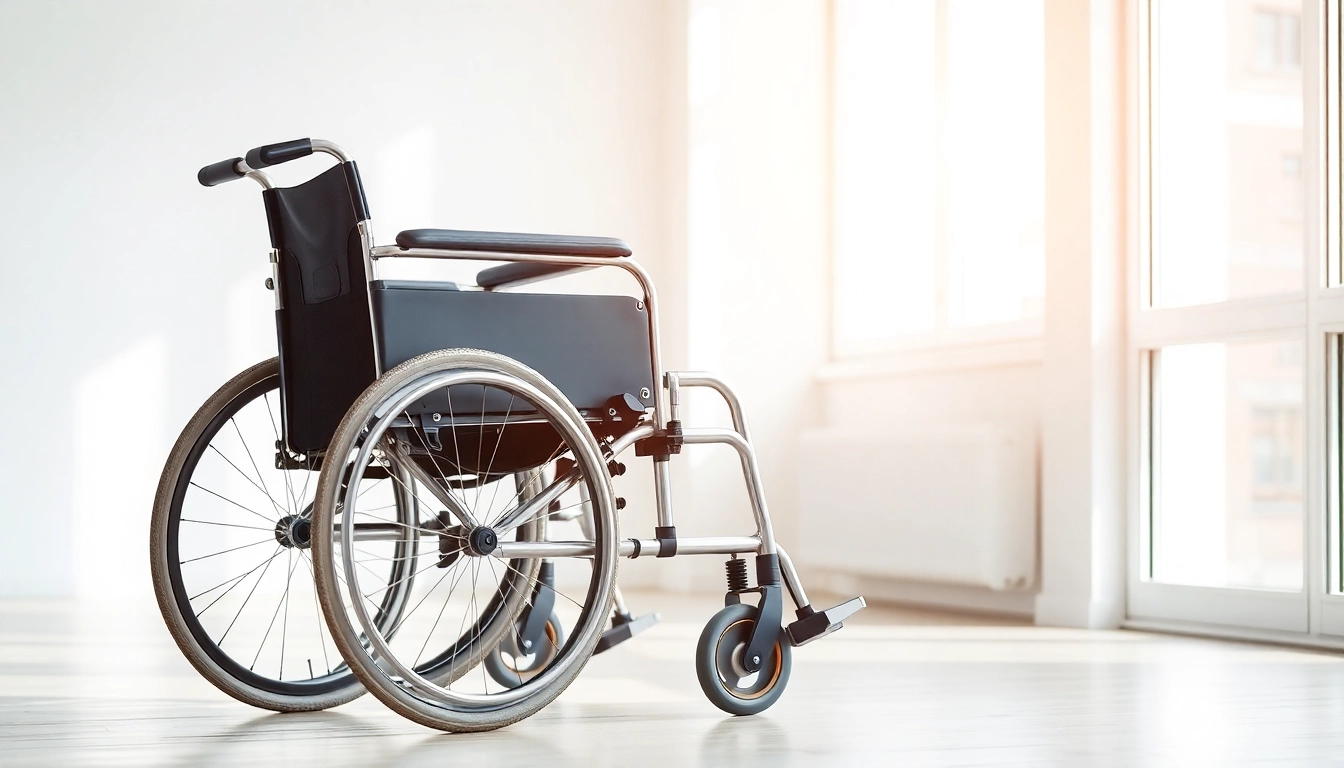Understanding Manual Wheelchairs
In the realm of mobility solutions, manual wheelchairs have served as indispensable aids for individuals with limited mobility. These wheelchairs are designed not only for ease of use but also to ensure that users maintain a level of independence and quality of life. Understanding what a manual wheelchair is, its key features, and the benefits it provides, is vital for anyone considering this essential mobility tool.
What is a Manual Wheelchair?
A manual wheelchair is a type of wheelchair that is propelled by the user or an assistant rather than powered by a motor. Generally, these wheelchairs come equipped with two large rear wheels and smaller front wheels. They are lightweight and designed to be maneuvered easily, making them an excellent choice for both indoor and outdoor use. Users can either push themselves using the hand rims attached to the large wheels or have someone push them, allowing for flexible user experiences.
Key Features of Manual Wheelchairs
To fully appreciate the utility of a manual wheelchair, it is important to understand the various features that different models may offer:
- Weight: Many manual wheelchairs are designed to be lightweight, making them easier to lift and transport.
- Frame Material: Most are made from aluminum or steel, balancing durability with weight.
- Seat Width and Depth: These can generally be adjusted to enhance user comfort and ensure a proper fit.
- Wheel Options: Variations exist for wheels, including puncture-proof tires and quick-release options for easy transport.
- Armrests and Footrests: Many come with adjustable armrests and footrests, enabling personalized comfort and support.
Benefits of Using a Manual Wheelchair
The advantages of using a manual wheelchair are manifold:
- Independence: Users can engage in everyday activities with less reliance on caregivers.
- Exercise: Pushing the wheelchair contributes to upper body strength and cardiovascular health.
- Cost-Effective: Compared to powered wheelchairs, manual options are often more affordable.
- Versatility: They can be used in various settings, from homes to public spaces.
- Flexibility: Users have the option to employ assistance when needed while still enjoying independence.
Selecting the Perfect Manual Wheelchair
Choosing the right manual wheelchair can be pivotal in enhancing mobility and independence. Several factors should be carefully considered when making this decision.
Assessing Your Mobility Needs
The first step in choosing a manual wheelchair is to assess your individual mobility needs. This assessment should include an evaluation of your physical condition, daily activities, and frequency of use. Consider questions like:
- Will you primarily be using the wheelchair indoors, outdoors, or both?
- Do you have the ability to self-propel, or will you need assistance?
- What are your weight and size considerations in terms of wheelchair dimensions?
- What routes or surfaces will you navigate, such as curbs, grass, or uneven terrains?
These considerations can guide you toward the model that best fits your lifestyle and capabilities.
Comparing Different Manual Wheelchair Types
There are several types of manual wheelchairs available, each tailored for specific use cases:
- Standard Wheelchairs: Ideal for general use, these are typically heavier but cost-effective.
- Lightweight Wheelchairs: Easier to transport, these wheelchairs are made from lighter materials, allowing for greater mobility.
- Sport Wheelchairs: Designed for athletic activities, these wheelchairs offer enhanced performance features.
- Pediatric Wheelchairs: These are tailored for children, with adjustable features to accommodate growth.
By examining the specific type that aligns with your mobility goals and daily activities, you can significantly improve your experience and comfort level.
Adjustable Features and Considerations
When selecting a manual wheelchair, adjustable features can be a game changer:
- Backrest Height: An adjustable backrest allows for customizable comfort and support.
- Seat Height: This is crucial for ensuring ergonomic alignment and ease of transfers in and out of the chair.
- Footrest Height and Angle: Adjustable footrests help in reducing fatigue and improving circulation.
Choosing a wheelchair with these features can have a direct impact on your overall comfort, usability, and experience.
Health Benefits of Manual Wheelchairs
Using a manual wheelchair can have several health benefits, enhancing the user’s quality of life.
Physical Exercise and Mobility
Pushing a manual wheelchair provides significant physical activity. Regular use contributes to upper body strength and improves cardiovascular health. Furthermore, it encourages users to stay active, which can combat the risks associated with a sedentary lifestyle. Studies have shown that regular upper body exercise can lead to improved functionality and a enhanced sense of wellbeing.
Enhancing Independence and Quality of Life
Many users report a substantial increase in their sense of independence after switching to a manual wheelchair. This sense of control over one’s mobility translates into better mental health, reduced anxiety, and an enhanced quality of life. Being able to navigate one’s environment independently empowers users to participate more fully in social, recreational, and professional activities.
Prevention of Health Issues
Using a manual wheelchair can also prevent numerous health complications:
- Pressure Sores: Regular repositioning and movement can minimize the risk of pressure sores.
- Muscle Atrophy: Engaging muscle groups used for propulsion helps prevent muscle wastage and other related health issues.
- Circumventing Dangerous Falls: For those with limited mobility, a wheelchair can provide a safer means of transportation than risking a fall while walking.
Engaging in daily activity with a manual wheelchair reduces health risks and improves overall physical condition, leading to a healthier and more active lifestyle.
Maintenance Tips for Manual Wheelchairs
Proper maintenance of your manual wheelchair is essential to ensure its longevity, reliability, and safety. Regular maintenance minimizes potential complications and enhances user safety and comfort.
Regular Inspections and Cleaning
Performing regular inspections is crucial. Check for:
- Tires: Look for signs of wear or insufficient inflation.
- Frame: Check for cracks or damages in the aluminum or steel frame.
- Brakes: Ensure brakes engage fully and are functioning correctly.
Regular cleaning should also be conducted to prevent dirt and grime buildup, which can impact functionality. Use a gentle soap and warm water for the frame, and avoid using high-pressure hoses as they can damage parts of the wheelchair.
Repairing Common Manual Wheelchair Issues
Common issues may arise, including:
- Flat Tires: Changing a tube or tire is essential; always keep a repair kit handy.
- Loose Screws: Regularly check and tighten bolts and screws as needed.
- Brake Issues: If brakes become less effective, replacing brake pads may be necessary.
Being proactive about addressing such issues can prevent more significant problems in the future, helping ensure a smooth and safe operation.
When to Seek Professional Help
While many maintenance tasks can be performed independently, some issues may require professional assistance:
- Frame Repair: Structural issues should be handled by a professional.
- Customization Needs: If adjustments or custom fittings are required, a specialist should assess these needs.
- Safety Checks: Consider periodic professional maintenance to ensure that all components work optimally.
Staying ahead of any potential malfunctions will extend the life of your manual wheelchair and enhance user safety and satisfaction.
Resources and Support for Manual Wheelchair Users
A range of resources and support systems are available for manual wheelchair users. These can provide invaluable assistance, whether you’re looking for financial help, community support, or additional information about accessories that can enhance your experience.
Community Support Groups and Organizations
Joining community support groups can be incredibly beneficial for users of manual wheelchairs. These organizations often provide educational resources and opportunities to connect with others sharing similar experiences:
- National Association of Independent Living Centers: Offers resources and advocacy for those with disabilities.
- Wheelchair Sports Organizations: Provide communities that encourage physical activity and sports engagement.
Such groups can also serve as therapy forums, helping users navigate the challenges and triumphs associated with being a wheelchair user.
Finding Financial Assistance for Wheelchair Purchase
Financial support is vital for those considering purchasing a manual wheelchair, especially if insurance does not cover this essential item. Resources for assistance include:
- Government Programs: Many countries offer financial aid programs specifically for individuals with mobility challenges.
- Nonprofit Organizations: Certain nonprofits may offer grants or loans for mobility aids.
- Fundraising Platforms: Online crowdfunding can also be an avenue for obtaining necessary funds.
Exploring these options can ease the financial burden related to acquiring a manual wheelchair.
Useful Tools and Accessories for Manual Wheelchair Users
Numerous tools and accessories can enhance the experience of using a manual wheelchair:
- Wheelchair Bags: For storing personal belongings and essentials.
- Cup Holders: Ensure hydration is never out of reach.
- Seat Cushions: These can maximize comfort and prevent pressure ulcers.
Custom accessories can make a significant difference in daily usability, ultimately enhancing the user experience.



